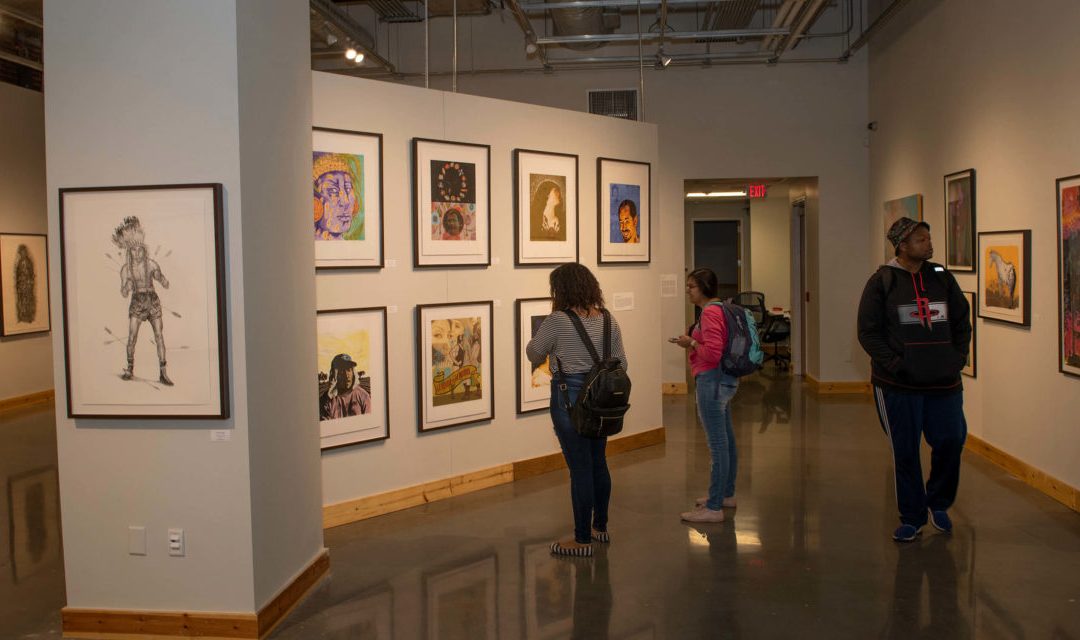Latino Art Now! (LAN!) is coming to Texas–at last! This week the first of 70 planned exhibitions opened. LAN! has been in Chicago, New York, Los Angeles, and Washington, but never in a Texas city. That makes the LAN! Conference in Houston ever more significant.
Over the next three months, the Inter-University Program for Latino Research (IUPLR) at the University of Houston Central campus will join up with the City of Houston to host LAN!. Universities, museums, art galleries, and cultural centers from across the city have signed on to promote exhibits and cultural engagements featuring Latino art.
My wife Harriett and I were honored to be involved with one of the first opening events of LAN! last week at the University of Houston- Downtown. Our show titled “Close to Home: Latinx Art and Identity” included 57 of the 100 Latino prints, oils, and watercolors that we donated to UH-Downtown. When the University of Houston-Downtown President Juan Munoz opened the exhibition, he noted that like the Romos, he had long been an admirer and collector of Latino art.
Mark Cervenka, managed to completely fill the Gallery space with striking images radiating with vibrant colors. The prints and paintings featured in this exhibition, the curator noted, “assert Latinx identity as specific, powerful, and ancient in origin.” Cervenka consulted with the Latino community on his campus to select a title and found general preference with the term “Latinx.” Latinx appealed to many because of its gender neutrality.
As long-time collectors of Latino art, we recognize the frequent shifts in identity terms. Two weeks earlier we opened a show of our collection at the McNay Museum of Art in San Antonio with the title “La Chicana.” Three years earlier our collection of 61 prints opened at the same museum with the title “Estampas de la Raza.”
Much of the art we have collected over 50 years originated in California and Texas. Initially, we bought art from students that I taught in college, and most were residents of East Los Angeles. They called themselves Chicanos. When we moved back to Texas we continued to buy from artists who for the most part preferred to be called Chicanos, Mexican Americans, and Mexicanos.
The 1980 United States Census, recognizing that Mexican Americans, Cubans, Puerto Ricans, and Central Americans were part of a growing ethnic community, attempted to include everyone from these communities under the umbrella term Hispanic. About that time the term Latino also came into vogue. Latino as an ethnic identification has grown in popularity in many communities in the past decade. Only time will tell if the term Latinx will supplant the other commonly ethnic terms used in Texas.
The curator of the University of Houston-Downtown show acknowledged that identity was something of great importance.“The artists declare their pride in who they are, a people descendant from ancient indigenous civilizations, connected to their land, nurturers of their children, but also creators of iconic images serving as potent standard bearers to any outsider.”
The Center for Mexican American Studies at the University of Houston, under the leadership of Dr. Pamela Quiroz, is credited for uniting her university with the City of Houston for the LAN! exhibitions. Dr. Quiroz is also the
Director of the Inter-University Programs for Latino Research (IUPLR) We were especially pleased to see the works of San Antonio artists included in the exhibit: Kathy Vargas, Cesar Martinez, Jesse Trevino, Ana Fernandez, Franco Mondini-Ruiz, Michael Menchaca, Armando Sanchez, Luis Lopez, Rolando Briceno, Angel Diaz-Rodriguez and Vincent Valdez.
Every art piece has a story. From 1969 to 1980 Harriett and I traveled throughout Mexico during our summer vacations and collected the works of numerous Mexican artists. The majority of our Mexican prints have been donated to the McNay Museum in San Antonio.
In the mid-1970s, we began collecting Chicano art from artists and printers that we met in Los Angeles and the San Francisco Bay Area. Many of our prints in the UH-Downtown exhibit were printed at Self-Help Graphics in East Los Angeles. It was at Self Help Graphics that we met two very important printers of this era–Sister Karen Baccalero and Richard Duardo. Sister Karen started Self Help Graphics on a shoestring budget and printed the works of young Chicano artists from East Los Angeles.
Duardo had been one of my Upward Bound high school students when I taught in the Los Angeles public schools. He entered UCLA in 1970 as an undergraduate art major at the same time that I began my Ph.D. program at UCLA in American history. A chance meeting ten years later in midtown Los Angeles brought us together and we became good friends and serious buyers from his newly established print studio, Modern Multiples.
We decided to donate some of our Latino art to the University of Houston Downtown campus largely because of the commitment that President Munoz made to place our art throughout the campus buildings. Over my seventeen years as president of the University of Texas San Antonio, we managed to add more than 2,000 works of art to the campus, much of it Latino art.
Houston is home to more than 2.7 million Latinos, making it the second largest Latino community in the United States after Los Angeles. Latinos represent one of every three residents of the city and demographic experts predict that the Latino population will grow by more than 20 percent in the next decade.
When it comes to the arts, much is expected of Houston. The LAN! exhibitions across the city may well be a strong beginning of a Latino cultural renaissance. If that’s the case, Houston will be an artistic center to emulate.


Recent Comments